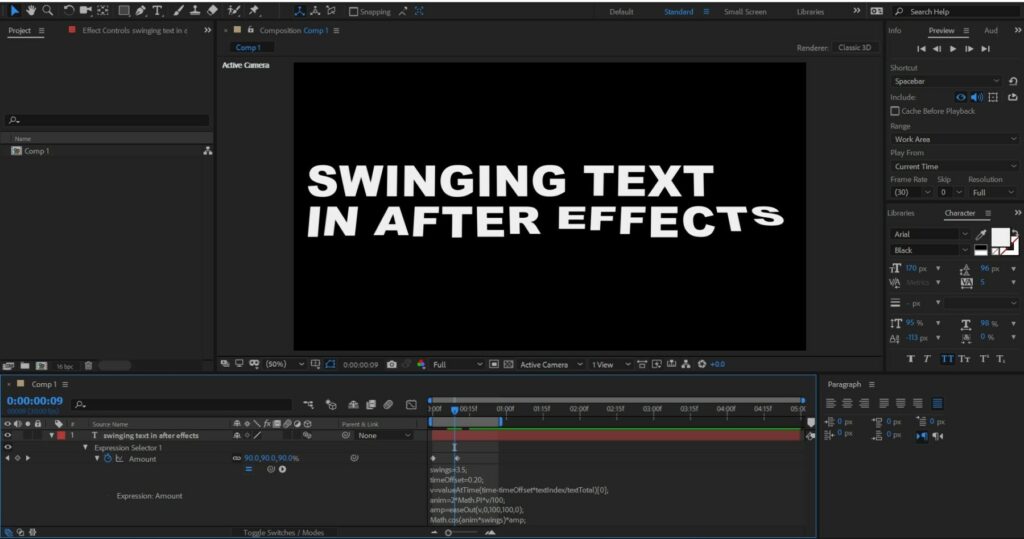Mastering Text Animation: A Comprehensive Guide to Animating Text in Adobe After Effects

Introduction:
Text animation is a powerful tool in the arsenal of motion graphic designers, allowing them to bring typography to life and create dynamic visual experiences. Adobe After Effects, renowned for its robust animation capabilities, provides a versatile platform for animating text in myriad ways. From simple transitions to complex kinetic typography, After Effects offers an extensive array of tools and techniques to unleash your creativity and elevate your text animations to new heights. In this exhaustive guide, we’ll delve deep into the world of text animation in Adobe After Effects, exploring everything from basic animation principles to advanced techniques, to help you master the art of animating text and create captivating visual storytelling.
Understanding Text Animation in Adobe After Effects:
Text animation in Adobe After Effects involves the manipulation of text layers through keyframes, effects, and expressions to achieve movement, transformation, and interactivity. Whether you’re animating individual characters, words, or entire paragraphs, After Effects provides a rich set of features and controls to customize the timing, style, and behavior of your text animations. From simple fades to intricate kinetic sequences, the possibilities are virtually limitless, allowing you to express your ideas and convey your message with precision and creativity.
Key Elements of Text Animation in Adobe After Effects:
Animating text in Adobe After Effects encompasses several key elements, including:
- Keyframes: Keyframes are the foundation of text animation in After Effects, allowing you to define the starting and ending points of animation parameters such as position, scale, rotation, opacity, and more. By setting keyframes at different points in time and adjusting their properties, you can create smooth, fluid motion that brings your text to life.
- Effects: Effects play a crucial role in text animation, enabling you to apply stylized treatments, transitions, and visual enhancements to your text layers. After Effects offers a wide range of effects, including blurs, glows, distortions, and color corrections, which can be used to add depth, dimension, and visual interest to your text animations.
- Expressions: Expressions are powerful scripting tools in After Effects that allow you to automate and control text animation parameters dynamically. By writing custom expressions or using pre-built expressions presets, you can create complex motion behaviors, procedural animations, and interactive effects that respond to changes in the composition, layer properties, or user input.
- Motion Paths: Motion paths define the trajectory of movement for text layers in After Effects, allowing you to animate text along straight lines, curves, or custom paths. By creating and editing motion paths using the Pen tool or motion path keyframes, you can create dynamic motion effects such as text reveals, tracking shots, and kinetic typography animations.
- Timing and Easing: Timing and easing control the speed and acceleration of text animation, influencing the rhythm, pacing, and feel of the motion. After Effects provides a variety of interpolation methods and easing curves that allow you to fine-tune the timing and motion curves of keyframe animations, ensuring smooth transitions and dynamic movement.
Step-by-Step Guide to Animating Text in Adobe After Effects:
Follow these step-by-step instructions to animate text in Adobe After Effects:
- Create a New Composition: Open Adobe After Effects and create a new composition by selecting “Composition” > “New Composition” from the menu. Set the composition settings, including resolution, frame rate, and duration, according to your project requirements.
- Add Text Layer: Select the Text tool from the toolbar and click anywhere in the composition window to create a new text layer. Enter your desired text, and use the Character and Paragraph panels to customize the font, size, color, alignment, and other typographic properties as needed.
- Set Keyframes: With the text layer selected, open the Transform properties by clicking on the arrow next to the layer name in the Timeline panel. Enable keyframe animation for the desired properties (e.g., position, scale, rotation, opacity) by clicking on the stopwatch icon next to each property name.
- Adjust Keyframes: Move the playhead to the desired start time for the animation, and adjust the text properties to define the starting state of the animation. Then, move the playhead to the desired end time for the animation, and adjust the text properties again to define the ending state of the animation. After Effects will automatically create keyframes at the start and end points of the animation.
- Preview Animation: Preview the text animation by scrubbing the playhead in the Timeline panel or by pressing the spacebar to play the composition in real-time. Adjust the timing, easing, and properties of the keyframes as needed to refine the animation and achieve the desired motion effect.
- Add Effects: Enhance the text animation by applying effects to the text layer from the Effects & Presets panel. Experiment with different effects, such as blurs, glows, distortions, or transitions, to add visual interest and style to your text animation.
- Use Expressions: Take your text animation to the next level by using expressions to automate and control animation parameters dynamically. Write custom expressions or use pre-built expression presets to create complex motion behaviors, procedural animations, or interactive effects that respond to changes in the composition or user input.
- Fine-Tune Motion Paths: If you’re animating text along a motion path, use the Pen tool or motion path keyframes to create and edit the trajectory of movement. Adjust the shape, curvature, and timing of the motion path to achieve smooth, fluid motion that follows the desired path.
- Preview and Render: Preview the final text animation by playing the composition in real-time, and make any additional adjustments or refinements as needed. Once you’re satisfied with the animation, render and export the composition as a video file by selecting “Composition” > “Add to Render Queue” from the menu and configuring the render settings.
Best Practices for Animating Text in Adobe After Effects:
To create compelling and effective text animations in Adobe After Effects, consider the following best practices:
- Plan Your Animation: Before diving into animation, plan out your text animation sequence and storyboard the keyframes, effects, and timing you want to use. Establish a clear vision for the animation’s style, tone, and narrative context, and use this roadmap to guide your animation process.
- Keep it Simple: Focus on conveying your message clearly and succinctly through your text animation, and avoid cluttering the animation with unnecessary effects or embellishments. Opt for clean, minimalist designs that prioritize readability and visual clarity, and use animation sparingly to enhance, rather than overpower, the content.
- Pay Attention to Timing: Pay close attention to the timing and pacing of your text animation, ensuring that keyframes are spaced evenly and transitions flow smoothly from one state to another. Experiment with different easing curves and interpolation methods to achieve natural, organic motion that feels dynamic and engaging.
- Experiment with Effects: Don’t be afraid to experiment with different effects and styles to add depth, dimension, and visual interest to your text animations. Try out various blurs, glows, shadows, and color treatments to create unique looks and atmospheres that complement your project’s aesthetic and theme.
- Test and Iterate: Test your text animations in different viewing environments and playback conditions to ensure they remain legible and visually appealing across a range of devices and screen sizes. Solicit feedback from colleagues, clients, or target audience members, and be open to revising and refining your animations based on constructive criticism and user testing.
Conclusion:
In conclusion, animating text in Adobe After Effects is a creative and rewarding process that allows you to breathe life into typography and create dynamic visual storytelling. By understanding the principles of text animation, mastering the tools and techniques of After Effects, and following best practices for animation design, you can produce compelling and effective text animations that captivate, inform, and inspire your audience. So, unleash your creativity, experiment with different animation styles and effects, and elevate your video content with visually stunning text animations that leave a lasting impression.




